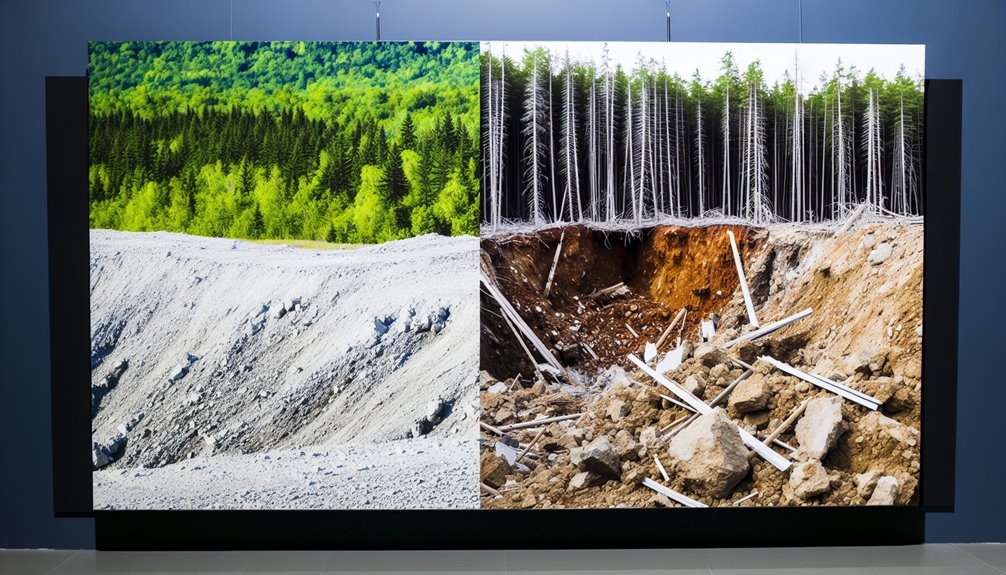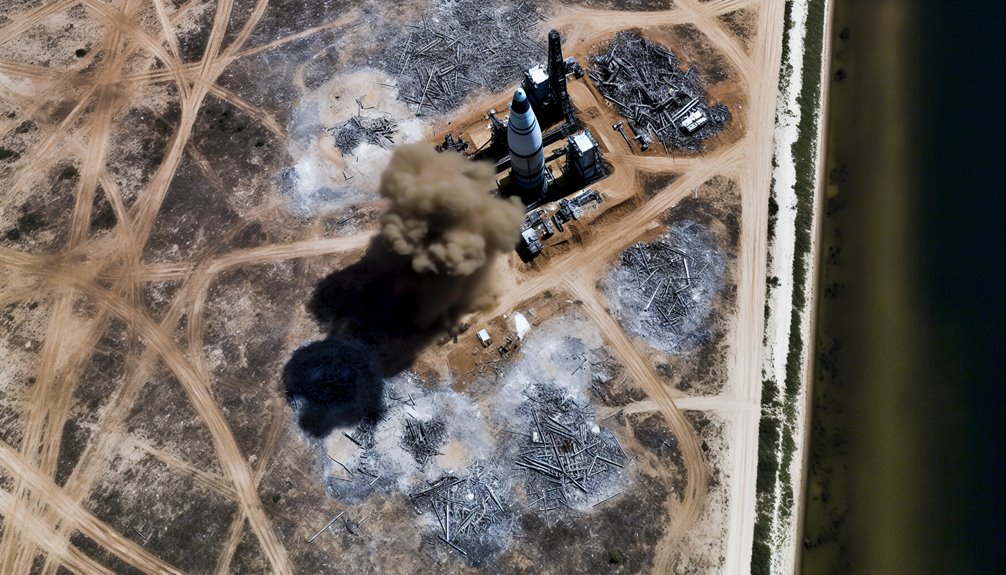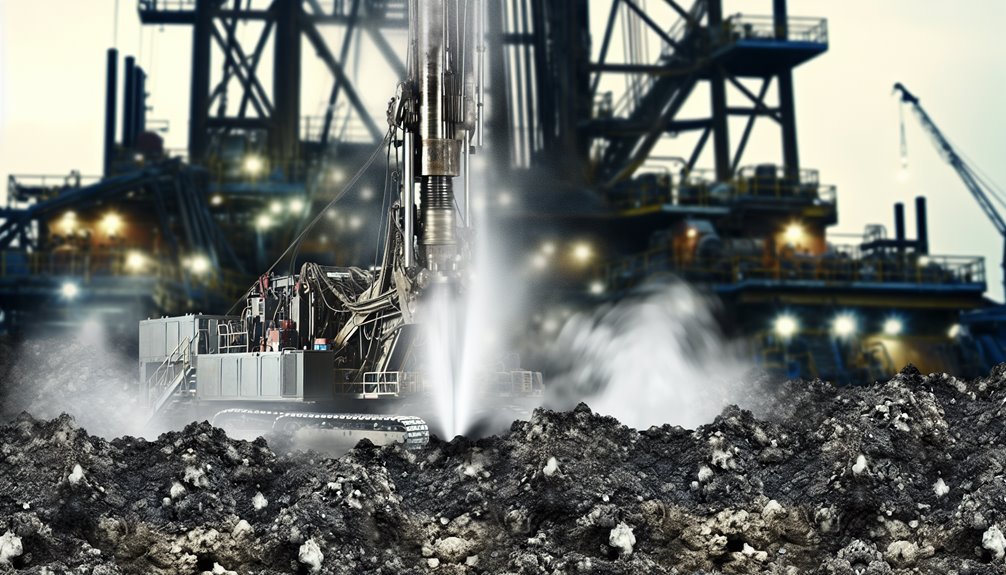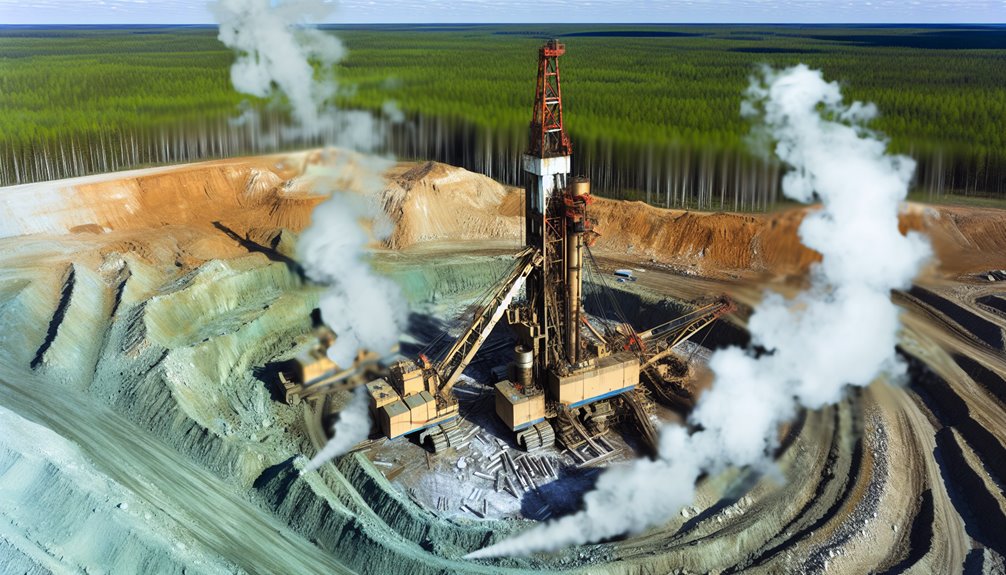As you explore the domain of missile boring, it's crucial to understand the environmental stakes involved. This technology, while efficient, poses risks to soil stability, potentially disrupting underground water channels and local ecosystems. You'll find that striking a balance between technological advancement and ecological preservation requires adherence to stringent regulations and proactive environmental management. Let's peel back the layers on how these operations impact the ground beneath us and the air around us, inviting a closer look at the practices that can mitigate these effects.
Understanding Missile Boring Technology

Missile boring technology utilizes an air-powered percussion tool, commonly known as a "mole," which efficiently punches through soil to install utilities beneath surfaces like roads and sidewalks. This method hinges on the missile's interaction with the soil, where its percussive action, driven by a high-pressure air compressor, enables rapid penetration with minimal surface disruption. You'll appreciate how missile efficiency is optimized through the careful management of air flow and pressure, which adapts dynamically to varying soil conditions. The process begins in an entry pit, progresses with potential intermediate pits for re-aiming in longer bores, and concludes in an exit pit. This precision minimizes environmental impact while ensuring that infrastructural enhancements proceed swiftly and smoothly. Additionally, missile boring is primarily effective in dry soils and is best suited for shorter distances, aligning with its non-steerable nature.
Soil Stability Concerns Related to Missile Boring
As you examine the effects of missile boring, it's essential to take into account how ground displacement risks manifest, particularly in areas with varied soil composition. Alterations to soil composition during the boring process can greatly impact the stability of nearby structures and the natural landscape. You'll find that cohesive soil layers, when disrupted, may compromise the arching effect that's critical for borehole stability, leading to potential subsidence and structural integrity concerns. Additionally, the high-pressure air used in missile boring can shift soil particles, potentially altering the water drainage patterns and affecting vegetation health.
Ground Displacement Risks
When contractors deploy missile boring techniques in various soil types, the risk of ground displacement and associated soil stability issues becomes a notable concern.
You'll find that soil displacement and borehole stability are vital factors to contemplate. Here are key insights:
- Soil Displacement: Heaving and displacement are pronounced in softer soils using an angled bit, leading to instability.
- Borehole Stability: Arching effects and cohesion greatly influence stability, making high cohesion and appropriate H/D ratios essential.
- Settlement Issues: Inadequately compacted areas exacerbate settlement, impacting structures.
- Mitigation Strategies: Utilizing compact drilling equipment and understanding soil characteristics help minimize risks.
- Design Considerations: Conservative load calculations are essential to accommodate potential ground movements.
These elements demand careful analysis and innovative approaches to guarantee environmental and structural safety.
Soil Composition Alterations
Understanding the impact of missile boring on soil composition is essential as you navigate the complex interplay of mechanical and environmental factors involved in this process.
The technique's efficacy hinges on recognizing how soil texture and compaction effects influence project outcomes. Cohesive soils like clay, while benefiting from natural arching, can complicate borehole stability and necessitate tailored drilling adjustments.
Compaction from the operation reduces soil porosity, impacting infiltration and aeration, thereby degrading soil health. Addressing these alterations requires a meticulous pre-boring soil analysis to anticipate and mitigate potential settlement and compaction issues.
This proactive approach guarantees the long-term stability of the borehole and the surrounding soil matrix, safeguarding both the environment and the infrastructure.
Effects of Missile Boring on Groundwater Quality

You need to contemplate how missile boring can impact groundwater quality through chemical contaminant leakage.
The disruption of soil permeability during boring operations may alter the natural recharge of aquifers, potentially leading to significant shifts in groundwater flows and quality.
It's crucial to monitor these changes rigorously to mitigate any adverse effects effectively.
Chemical Contaminant Leakage
As missile facilities operate, they often utilize hazardous chemicals like Trichloroethene (TCE) for degreasing parts, which can leak and severely impact groundwater quality.
You'll find that the profound effects on groundwater stem from various contamination sources, including:
- TCE and its breakdown products like cis-1,2-DCE
- Lead from firing ranges
- RDX residues from explosives
- Vinyl chloride from PVC production
- Tetrachloroethene from cleaning processes
These chemicals contribute to prolonged chemical exposure in the groundwater, often exceeding safe drinking limits and affecting adjacent ecosystems.
You need to be aware that contamination doesn't just stay put; it migrates, influenced by groundwater flow, ultimately posing risks well beyond the immediate area of the missile facilities.
Soil Permeability Disruption
When missile boring operations disrupt the natural stratification of soil layers, the effects on groundwater quality become notably pronounced.
You'll find that excavation and backfilling activities can greatly alter the composition and structure of the soil. This alteration affects the soil's infiltration rates, leading to uneven water retention and increased soil erosion.
As these layers are disturbed, thin clay barriers, which once regulated water flow, might no longer function effectively. This disruption not only compromises the soil's ability to absorb and retain water but also fosters conditions conducive to sediment loading.
Such changes intensify erosion, potentially releasing more sediments into surface waters, thereby degrading water quality and harming aquatic life.
Aquifer Recharge Alterations
Building on the disruption caused by missile boring in soil permeability, another significant concern arises with aquifer recharge alterations.
The integration of drilling techniques and the materials involved can directly affect groundwater recharge, creating pathways for contaminants.
Here's how this happens:
- Continuous Conduits: Create links between aquifers, mixing water qualities.
- Drilling Muds: Introduce new contaminants into clean aquifers.
- Borehole Sealing: Inadequate sealing allows for persistent contaminant pathways.
- Chemical Releases: Drilling muds can release harmful chemicals, altering water chemistry.
- Long-term Risks: Degraded muds and improper borehole closures prolong the risk of groundwater contamination.
You'll need to focus on meticulous planning and robust monitoring to manage these impacts effectively.
Impact on Local Wildlife and Biodiversity
While missile boring contractors endeavor to minimize environmental disruption, the impact on local wildlife and biodiversity remains a concern.
You'll find that new utility corridors and temporary construction are strategically placed along existing paths to reduce habitat disturbance. Particularly, construction within Priority Habitat Management Areas is tightly regulated to protect the Greater Sage-Grouse during critical breeding periods.
No permanent roads will emerge, preserving the natural landscape. Additionally, any affected areas undergo restoration to their original state, supporting long-term biodiversity protection.
Special measures protect not only the Sage-Grouse but also species like the Canada lynx and grizzly bear, with extensive mitigation strategies such as habitat improvements along key watercourses, ensuring a commitment to wildlife conservation amidst development pressures.
Air Quality and Emissions During Missile Boring Operations

Monitoring air quality during missile boring operations is essential, as these activities can greatly impact local air conditions. The emissions sources include particulate matter, volatile organic compounds, carbon monoxide, and nitrous oxide, all of which are common in drilling operations. The variation in emissions is influenced by soil type and drilling conditions.
Here are key points to take into account for effective monitoring:
- Place monitors at sites where the highest pollutant concentrations are expected.
- Take into account wind direction and other environmental factors in site selection.
- Guarantee multiple monitoring points to capture thorough data.
- Keep monitors close to residential areas and sensitive environments.
- Regularly maintain equipment to minimize emissions.
Understanding and managing these factors are critical in preserving air quality during these operations.
Best Practices for Environmental Protection in Missile Boring
To effectively safeguard the environment during missile boring operations, it's crucial to adhere to several best practices in site preparation, surface disruption minimization, and management of drilling byproducts.
Start by accurately locating underground utilities and conducting thorough surveys to guarantee the chosen path respects ecological sensitivities.
Utilize directional boring to slash surface disruption and prevent extensive open-cut trenching.
Employ temporary berms or sandbags to contain drilling mud and spoils within the operation zone, preventing contamination of nearby waterways.
Opt for environmentally safe drilling mud, like bentonite, and confirm its proper disposal.
After operations, restoration and careful monitoring are critical to guarantee the area returns to or exceeds its original condition, thereby maintaining a commitment to robust environmental protection.
Regulatory Landscape and Compliance for Missile Boring Contractors

Maneuvering the regulatory landscape for missile boring contractors is critical, as it involves various licenses, permits, and compliance measures that directly impact project execution and environmental stewardship.
You'll need to navigate through:
- Licenses and Certifications: Obtain specific drilling and pipeline contractor licenses.
- Environmental Permits: Secure permits for protecting local ecosystems.
- Right-of-Way Permits: Essential for accessing necessary lands.
- Utility Locates: Identify pre-existing utilities to prevent disruptions.
- Background Checks: Mandatory for projects on sensitive properties.
Noncompliance isn't an option. It can lead to severe legal penalties, financial losses, and reputational damage, not to mention the potential for significant environmental harm.
Early engagement with regulatory bodies and thorough compliance strategies are your best defense in maintaining regulatory compliance and ensuring environmental oversight.
Conclusion
As you explore the environmental impacts of missile boring, it's vital you dive deep into soil stability, groundwater integrity, and biodiversity preservation. You'll find that adhering to robust best practices and regulatory compliance isn't just necessary, it's fundamental for sustainability. Emphasizing thorough site assessments and post-operation restorations will mitigate adverse effects. Remember, your commitment to environmental stewardship not only guarantees project success but also protects the ecological balance around you.
If you're interested in learning more about how we can work together to promote environmental responsibility in missile boring, I invite you to visit Boring Bros at boringbro.com or give us a call at (954) 639-6167. We're here to share our expertise and help you navigate the best practices for a sustainable future. Let's make a positive impact together!

